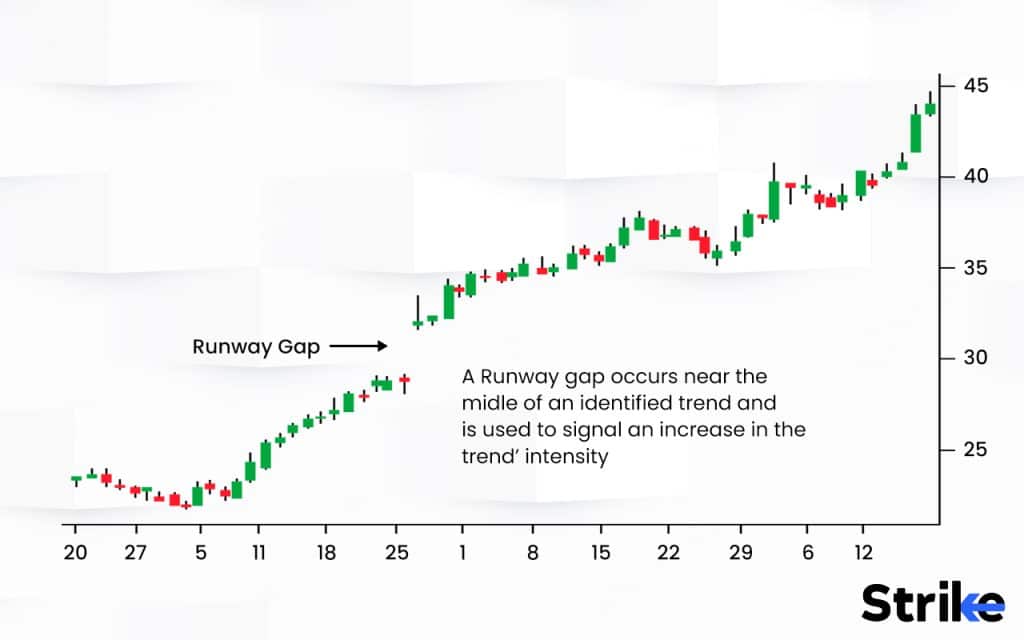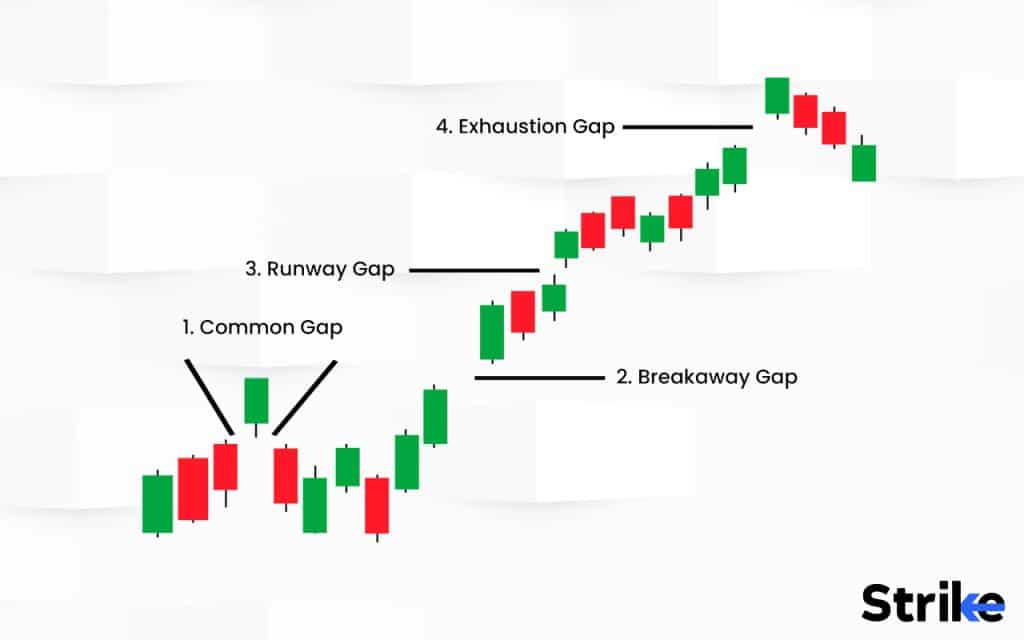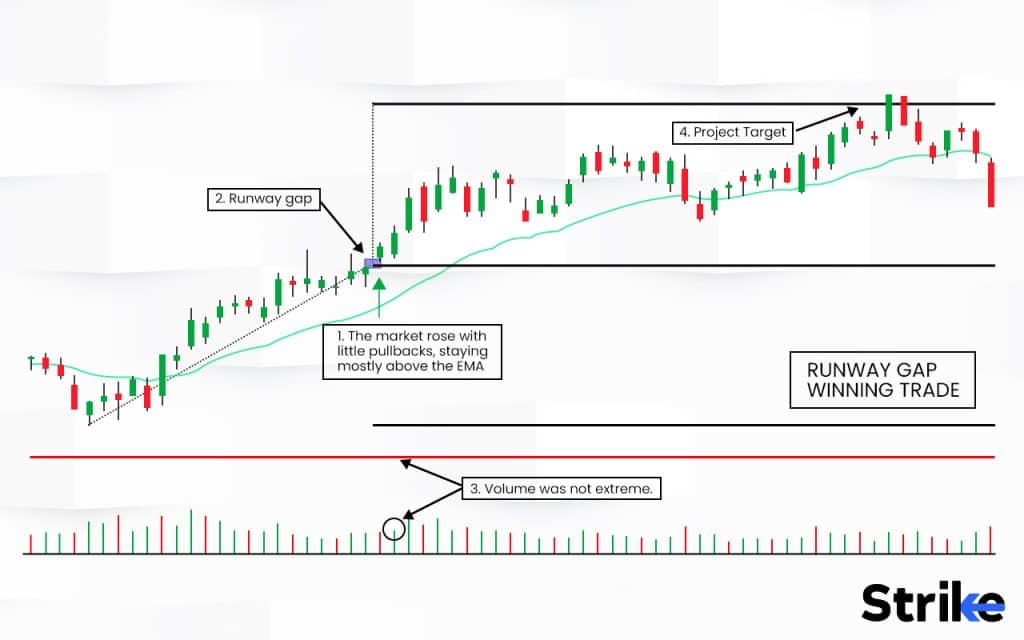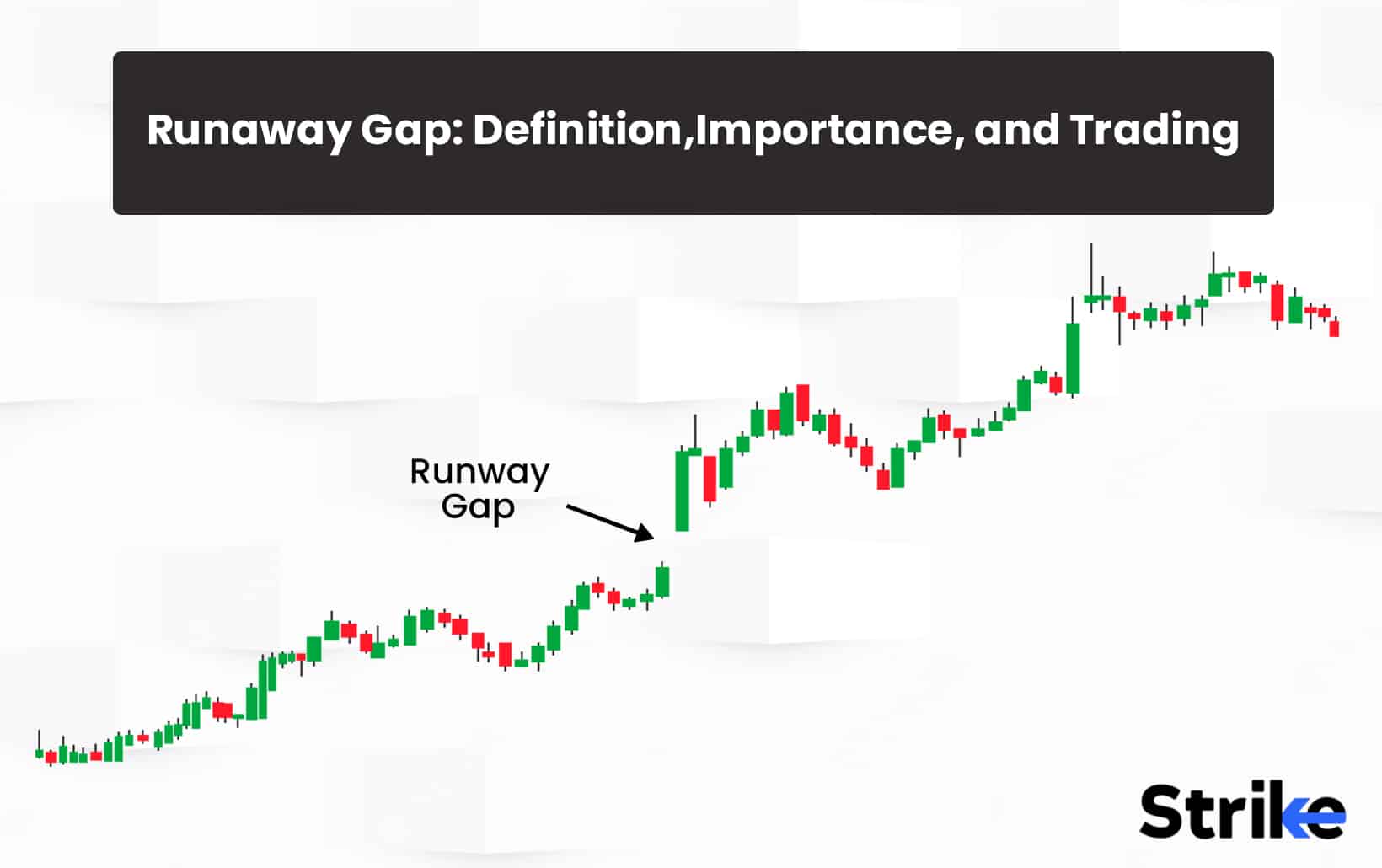A runaway gap is a huge price difference between two consecutive trading sessions that happens in the financial markets, often in the stock or commodity charts. The Runway Gap is identified by a gap in the price chart, where the beginning price of the current session is either higher (in an upward runaway gap) or lower (in a downward runaway gap) than the closing price of the previous session. There is no trading activity to close the gap in between in the runaway gap.
Runaway gaps are significant because they have the ability to serve as powerful continuation signals in technical analysis. It denotes a quick and large change in market sentiment, frequently brought on by important fundamental or technical variables. Runaway gaps, which show a significant imbalance between buying and selling pressure, are typically accompanied by greater volatility and momentum in the gap’s direction. Runaway gaps are so important to traders and investors because they provide insightful information and trading chances.
Runaway gaps frequently display a continuation pattern, indicating that the current trend is probably going to continue. These gaps are extensively watched by traders and investors because they reveal market dynamics and are used to predict future price changes.
What is a Runaway Gap in Technical Analysis?
A runaway gap is a term used in technical analysis to indicate a huge price gap that appears in a chart pattern and signals the continuation of the current trend. It is sometimes referred to as a measurement gap or an exhaustion gap. Runaway gaps emerge during strong and sustained movements, whether an uptrend or a downturn.

A runaway gap in technical analysis can arise in both uptrends and downtrends. It emerges as a sizable upward gap when the market is trending upward, signaling an increase in investor elation and purchasing pressure. This indicates that buyers are eager to pay higher prices for the item right away, without first waiting for a retracement or retreat. It has a strong bullish attitude and frequently results in future price increases.
A runaway gap, on the other hand, appears as a sizable downward gap when a trend is down, indicating more selling pressure and a pessimistic outlook. It suggests that there is an oversupply of the asset and that sellers are willing to unload their holdings at a loss. Such a gap strengthens the downward trend and frequently triggers subsequent price drops.
What is the other term for the Runaway Gap?
The other term for runaway gap is known as measuring gaps. It is termed such because it appears mid-trend and marks a potential price target for the move.
How does Runaway Gap differ from other types of Gaps?
Runaway gap differs from other type of gaps in terms of high trading volume & middle of the trend occurrence. Runaway gaps have special importance as opposed to usual gaps, which are caused by typical market volatility and are typically seen as brief disturbances in the price movement.

Runaway gaps are different types of gaps. They frequently indicate the continuation of the current trend, serving as a powerful affirmation of the mood of the market. Runaway gaps are frequently seen when market players display high confidence in their trading decisions, such as during moments of extreme market euphoria or increased anxiety.
What is the importance of Runaway Gap?
A runaway gap is a significant disparity in prices that happens during a strong, quick trend in technical analysis, signaling the continuance of the current trend. The following are 5 key points about the importance of runaway gaps:
Runaway gaps frequently take place in the midst of an ongoing trend, whether it is bullish or bearish. Their inception and subsequent unfulfilled status serve as a testimony to the intensity and propensity of the existing tendency. Runaway gaps may be used by traders and investors to confirm their research and make wise judgments.
The appearance of a runaway gap implies an abrupt increase in purchasing or selling pressure, signalling a substantial shift in market sentiment. This gives traders information about the strength and velocity of the trend, enabling them to judge the level of market participants’ conviction and maybe spot profitable trading opportunities.
Runaway gaps are included in some traders’ trading techniques as entry and exit signals. As they view these gaps as a solid confirmation of the market’s attitude, they may use them as entry signals to launch fresh positions in the trend’s direction. On the other hand, the ultimate closing of a runaway gap may serve as an exit signal, indicating a likely trend reversal or weakening.
The emergence of a runaway gap confirms the strength and endurance of the trend. It suggests that the trend has the ability to last for a considerable amount of time because the current market attitude is strong enough to drive prices decisively.
Runaway Gaps offers insightful information about market mindset. A runaway gap occurs when there is a high amount of excitement or panic among market participants. Runaway gap features be studied and analyzed to help traders better understand the psychology and sentiment of the market, which can guide their trading decisions and risk management tactics.
These are a few of the importance of the runaway gap which make it a significant tool for traders and investors.
How to Recognize a Runaway Gap?
A Runaway Gap is identified by its distinct features. First, it occurs within an established trend, reflecting a burst of momentum in the direction of the prevailing trend. Second, the gap itself is much larger than normal, significantly exceeding the previous day’s trading range. This reflects urgency among traders who rush to get into the move.
Third, the large gap is accompanied by a spike in trading volume as fresh money pours into the asset. Finally, there is no price overlap between the prior candle and the gap candle since the gap exceeds the previous range. These characteristics differentiate a dramatic Runaway Gap from more mundane daily gaps within a trend. Traders take note as a properly identified Runaway Gap suggests the trend has further room to run and the size of the gap approximates the next potential swing.
How often does a Runaway Gap appear?
Runaway gaps happen more frequently in markets that are strongly moving as investors’ excitement or anxiety grows. Runaway gaps are more common during times of market euphoria or fear because traders and investors show greater conviction. The timescale being studied affects the frequency of runaway gaps as well. Runaway gaps be less frequent on shorter timescales like hourly charts than on longer timescales like daily or weekly charts.
Do Runaway Gaps get filled?
Yes, runaway gaps get filled, however, less frequently than other kinds of gaps. Runaway gaps are notable for having the propensity to be unfilled for a lengthy period of time, which increases their relevance and attests to the potency of the current trend.
It’s crucial to keep in mind that market dynamics are unpredictable and that various factors affect price changes. This occurs when fresh information becomes available, market circumstances alter, or a sizable counter-trend movement takes place.
How do traders react to a Runaway Gap?
A runaway gap frequently prompts traders to employ a certain set of tactics and methods. Following are 5 typical responses and activities traders make when they come across a runaway gap. Traders who use trend-following methods could interpret a runaway gap as a strong confirmation of the current trend. They read the gap as a sign of consistent momentum and place trades in that direction in anticipation of the trend continuing. These traders could start new positions or increase those that already exist in an effort to take advantage of the momentum and benefit from more price swings in the same direction.
Runaway gaps are sometimes used by traders as precise entry or exit indications. For instance, a trader would wait for a runaway gap to form before placing a trade since they believe it to be a powerful sign of the trend’s strength. The trader decide to withdraw, on the other hand, if a runaway gap appears against a trader’s position, indicating a probable reversal or loss of momentum.
Traders frequently modify their stop-loss orders when a runaway gap occurs. A trader decides to lower their stop-loss levels to safeguard gains and reduce possible losses if they already hold a position in the gap’s direction. This method aids in risk management in the event that a substantial price reversal occurs after the runaway gap.
Runaway gaps indicate the persistence of a trend, but traders also keep an eye out for indications that a trend may be reaching its limits. They keep an eye on future price movements and indicators for any indications of a trend’s waning or prospective reversal. Traders can think about changing their holdings or taking gains to prevent getting caught in a market reversal if other technical indicators or price patterns point to a likely trend reversal.
Runaway gaps cause price ranges to widen and volatility to rise. The increased price swings and wider trading ranges present possibilities for traders that specialise in volatility-based methods. They could use techniques like volatility scalping or breakout trading to benefit from the heightened market activity that follows a runaway gap.
Traders’ responses to a runaway gap depend on their trading approach, plan, and level of risk tolerance. Some traders see it as a resounding affirmation of the current trend and change their holdings accordingly, while others proceed with caution and keep a careful eye on the market for potential reversals or symptoms of tiredness.
What trading strategy can be associated wiith Runaway Gap?
The Runaway Gap signals a potential continuation of the overall trend, so traders can capitalize on this high-probability move. When a Runaway Gap occurs, traders should first confirm the gap remains unfilled after a few candles, indicating sustained directional conviction. With the trend confirmed, traders can enter new long positions if the gap appears in an uptrend, or new short positions if it occurs in a downtrend. Stops are placed below the gap candle’s low for long trades, or above the high for short setups.

Profit targets are calculated projecting the size of the gap upward or downward. Traders may use a trailing stop or partial profit-taking strategy to capture gains if the target is hit. This approach allows capitalizing on the momentum implied by the Runaway Gap while managing risk. The gap helps time entry, set risk parameters, and estimate the swing potential to trade with the prevailing trend momentum.
When is the best time to trade Runaway Gap?
A runaway gap is best traded in the early stages of its formation. A runaway gap is characterised by a substantial price difference that appears in the middle of an established trend and suggests that the trend will continue. This kind of gap typically appears after a significant move in the direction of the current trend, indicating that the trend is gaining strength. It is advisable for a trader to open a position as soon as the runaway gap develops in order to profit from the trend’s continuance and maximise potential gains. This early entrance enables traders to profit from the market’s significant upward or downward movement by riding the wave of momentum.
Can Runaway Gaps be considered reliable Indicators?
Yes, runaway Gaps are useful indicators, but should not be considered 100% reliable on their own for trading signals. They are best combined with other technical indicators and analysis.






 Previous Article
Previous Article






No Comments Yet